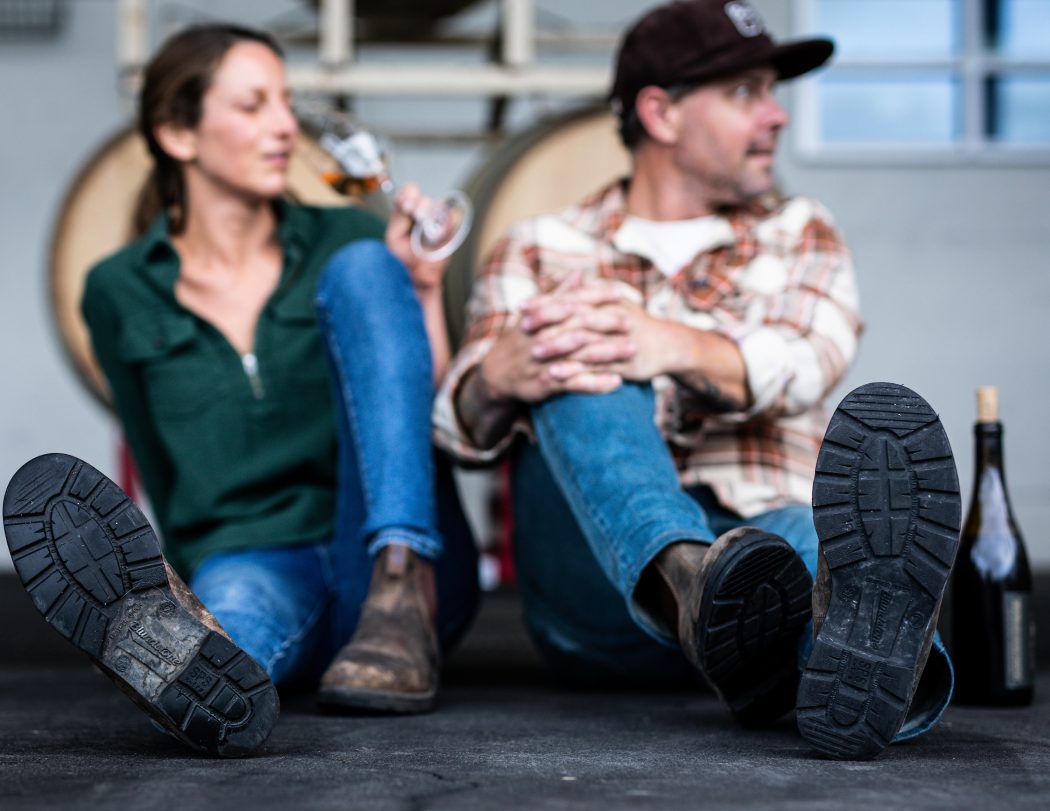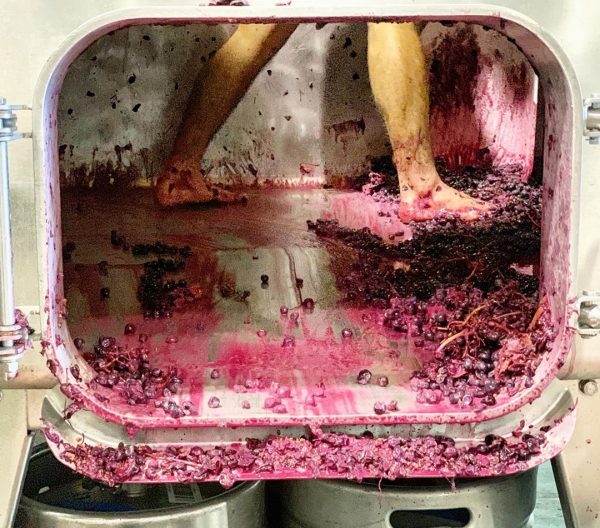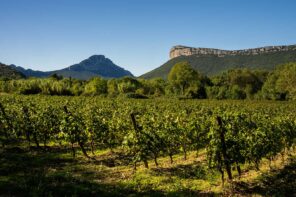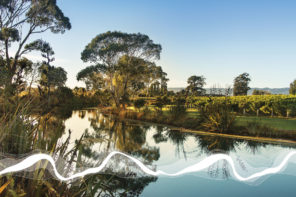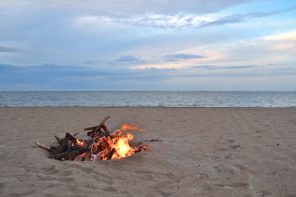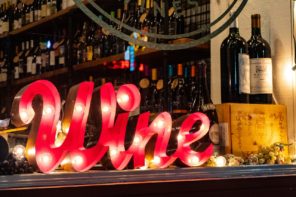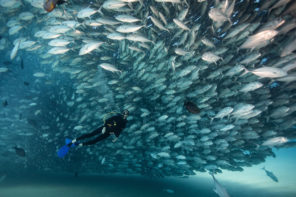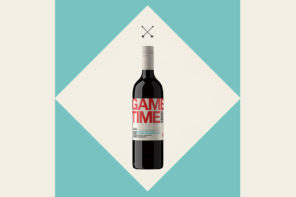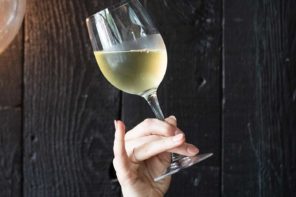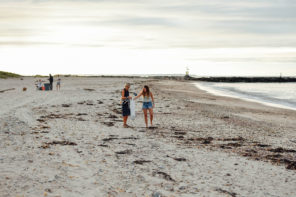Feet First
Photos by Leigh-Ann Beverley | @bonafideproductions
They say the couple that spends 12-hour-long days digging out tanks full of tons of grape skins together, well, A) both better be pretty good at giving back massages and B) must really like spending time together. We have not certified either Scott and Jenny Schultz in any chiropractic training course, but we can confirm they really enjoy hanging out with one another. Other things we can confirm: it takes a lot of beer and a couple of good pairs of Blundstone boots to make good wine. As a winemaking team, they spend an awful lot of time on their feet but at least their Blunnies lessen the blow. The couple’s wine brand, Jolie-Laide makes wines in Western Sonoma County that you might find unfamiliar at first, but intriguing. A skin-contact trousseau gris with a label drawn by a tattoo artist from San Francisco might not be in the back of your fridge right now, but you might have your new favorite wine once you give it a chance.
Jenny had a degree in chemistry when she went to UC Davis to study winemaking after dabbling in wine appreciation classes led her toward tanks. Scott worked as a sommelier for Thomas Keller, zooming from Chicago to Vegas to finally landing in Napa Valley at Keller’s Bouchon. There he jumped right into wine with both feet. They met a couple of years later at a winemaking facility in Sebastopol, California, where Scott was working when she came for a tasting. And this year she’s joined him at Jolie-Laide.
We talked barrels, boots and bottles with Scott and Jenny.
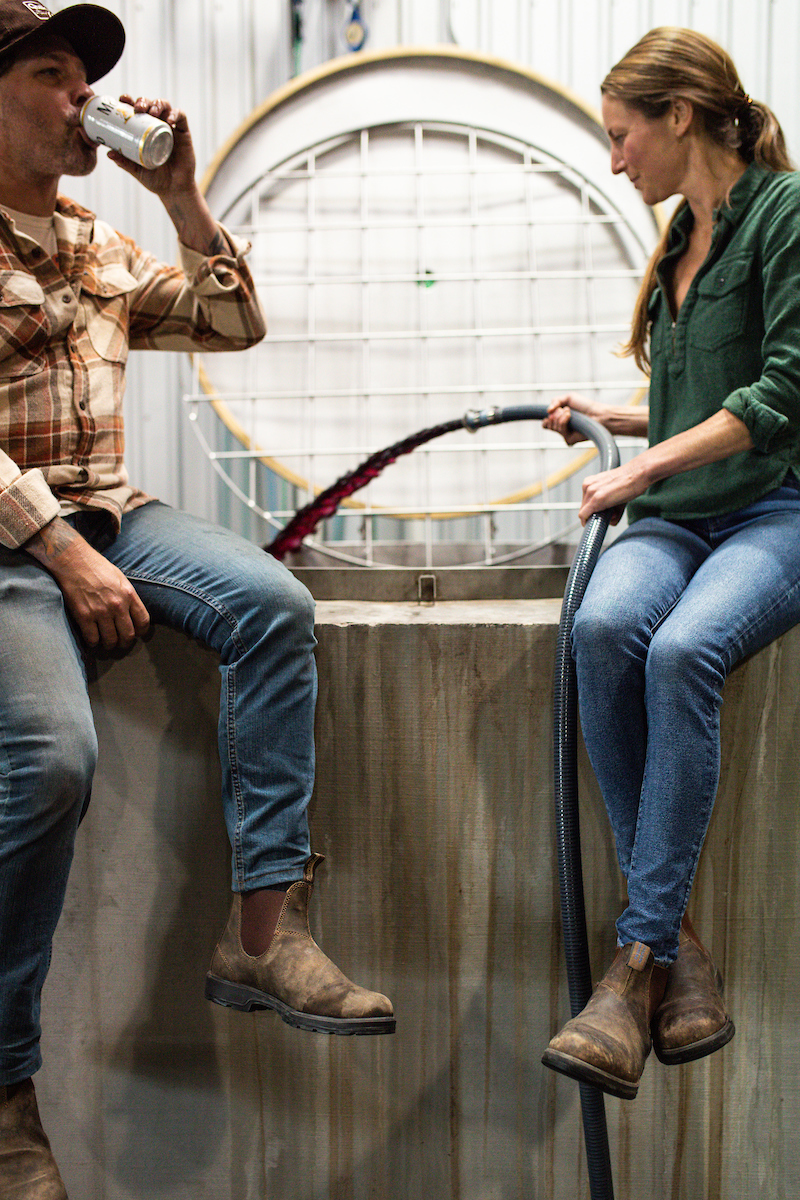
It might take a lot of beer to make good wine, but only one pair of Blundstone boots.
Scott, How did you go from the restaurant world serving wine to making it?
Scott: I’ve always worked in restaurants in every capacity, front and back of the house. And once I accepted a job from the Keller Group, they moved me from Chicago to Vegas to Yountville. Once I got to Yountville, the opportunity changed from, in Chicago, I could read about wine, but once I got here, I realized everybody that I came in contact with was Christian Moueix or the Schafers—all these vintners, winemakers, cellar masters, viticulturists, all these guys would come and hang out at Bouchon. And I was like, “Oh, that’s cool. I want to check out harvest.” In restaurants, we are used to stodging, where you go to work somewhere for free to learn something.
I did a lot of that in the restaurants. So I just grabbed a couple of guys and said, “Hey, can I come check out harvest?” And loved it, and one of those guys was Juan Mercado from a winery called Realm. I essentially just hung out with them for the 2007 harvest every second I could get away from the restaurant.
They offered me to stay on. They were in a growth phase, and they had never had a cellar master or assistant winemaker. Of course, that was terrifying to me because I didn’t have any experience either. And it was like, “Oh, don’t worry. We have a winemaker. All you have to do is be able to execute what he wants. He’s going to come in and write work orders.” So I stayed on. I was with them for a couple of years. Nothing against Napa Cab, but it just wasn’t really my thing. So that’s when I left them in 2010 to go work for Pax and Wind Gap, who essentially, I’ve worked for, for the next eight years or something. Working for Pax is where I started Jolie-Laide.
As a couple who works together, like intense long hours together, what are some of the best and worst parts?
Scott: Damaging question. But for years, we both had separate jobs. Jenny’s been the winemaker at a bunch of different projects. I was working for Wind Gap and Pax as the winemaker, all while having Jolie-Laide just as a side project. And then I phased out when Wind Gap left, so I became the sole employee, I guess you would say, for Jolie-Laide. Jenny still had a couple of other jobs. And then only as of this year have we been doing it together. Honestly, there’s no … thus far, the honeymoon has not ended. It’s been so much easier having both of us with all of our attention on it. Even in a year like this, where the sky is falling, we get so much more done. It’s so much better, so much easier to do it as a team.
Jenny: We have our separate strengths, too. I don’t know… it’s made me really appreciate Scott even more for all the actual hands-on, hardwork he’ll do when I can’t handle it. Of course, it’s difficult to work with your significant other. You have to go home with them and eat dinner with them after a crazy day. But it’s actually been really refreshing.
Scott: It’s such a dichotomy because we came to wine so differently. Whereas I grew up in restaurants, so I was exposed to wine, working in fine dining as a kid. Where Jenny had zero experience in wine, but she graduated with a chemistry degree from Villanova and was working in pharmaceuticals. Someone gifted her a wine class, and she was like, “Oh, this wine thing is cool. There’s obviously science in wine.” She came to Davis, got her master’s degree, and then started working in the industry. She and I actually started the industry at the same time.
Even in a year like this, where the sky is falling, we get so much more done as a team.
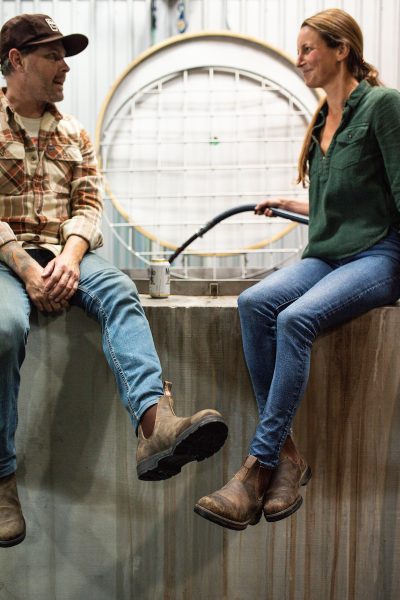
Jenny, what made you switch course into wine?
Jenny: Around my senior year of college was when I was dating this guy who was super into food, like cooking. We would always buy these cheap, fun Spanish wines. Because over on the East coast, you can find more fun, interesting European wines. Yeah, we went to a wine class in Philly one time and then kept going back and learning more. I put the two together that there was science in wine, because of course, I had zero idea of that coming from New Jersey and growing up in a family that never ever drank wine.
I just started reaching out and doing some research on all the schools in the US that had programs. The only way I knew to learn about it was to go to school. I wasn’t even really aware that you could come and do a harvest with zero experience. Which in the long run, I wish I had done a harvest first because I was a bit lost on the winery side of things at Davis, because we didn’t have a functioning winery there. But it was awesome. I was there for two years and graduated in ’09, and then just started working harvest all over the place. I did a harvest in New Zealand and two in South Africa. I did the globe-trotting for a bit and ran out of money really quickly and decided to stay here in California.
There’s probably more chemistry to even basic winemaking than most people realize.
Jenny: Yeah. It can be really scientific if you want it to be. It doesn’t necessarily have to, but it’s definitely a plus to have it in your back pocket.
Scott: It’s funny because the way that we make wine is so rudimentary, and Jenny does have the knowledge, and if something goes squirrelly, then we have the backup, because … I make a shitty analogy just because I’m a restaurant person, but there’s Harold McGee, the food science guy. There are all these chefs that could tell you exactly what’s happening when you’re cooking something. But most home cooks, there’s a lot of people that just know how to cook something. They don’t know exactly what’s happening while you’re doing it, where I’m totally that way with wine. I couldn’t elaborate. I couldn’t wax and wane very poetically about all of the things that are happening during fermentation. At the same time, I know you crush the grapes, you do this, you do that. This will make it ferment like this. I know the end result, so we tend to make it happen.
What’s a typical day during harvest like?
Scott: It’s a busy workload, but harvest is just whatever mother nature decides to hand you. Sometimes it’s a 40 or a 50 hour week, and sometimes it’s an 80 or 100 or 120 hour week. It just kind of is what it is. The days start at 6 a.m. and end at 8 or 9 p.m.
We didn’t have too many super late crazy nights this year, but sometimes if you’re still pressing at midnight or 1 a.ma, you order some food or make some dinner and just try to keep the interns happy. We have an extremely fun workspace that’s shared with, as I said, Pax and all those guys. It’s a really good team and it’s big lunches, lots of bottles of wine open. Maybe that makes our days a little bit longer too, but we like to make it fun for everybody. It’s a lot of loud music and we have beer on tap, we have coffee on tap. It’s a big friendly place.
Maybe that makes our days a little bit longer too, but we like to make it fun for everybody.
We kind of take for granted that Blunnies are perfect winery shoes, good things to wear on the crush pad, and so forth—
Scott: We’re both wearing them right now.
What makes the Blundstone boots so good for winery work?
Scott: They’re great because they’re totally utilitarian, stable and, yes, you can pull them on and off super fast. We’re getting in and out of tanks all day. We literally do foot stomp everything, so we’re always taking our shoes off and jumping in bins. That’s another reason we love them. Obviously, they’re good for jumping up and down on racks, being in the vineyard, climbing on tanks, whatever.
You guys are working with some esoteric grapes, some techniques that might be unfamiliar to a lot of wine drinkers. How do you explain your wine to somebody who’s curious to try them, that might not be that familiar?
Scott: So Jolie-Laide, the Jolie is pretty and Laide is ugly—pretty-ugly—so, unconventionally attractive. Kind of different, but good. That was born out of, I came from a lot of restaurants that we worked with very worldly wine lists. Then when I got to Napa, all of a sudden, it was this utter myopia of just cabernet and a little chard and pinot, and it just drove me nuts that nobody cared about the rest of the world of wine. When we had the opportunity to make some wine, we want to do anything but chard, pinot, cab. We’re not picking on them exclusively, but our interests just lay more in the esoteric.
Jenny and I just love a lot of whites that have a lot of acid and that are really pretty—we could drink champagne all the time—and I think that transcends into our own wines. They’re a little bit leaner, but with lots of acids. But we’re really big on freshness and preservation. But yeah, that’s why we do everything from melon de Bourgogne, which is all in concrete. We do trousseau gris, which we do a little bit of skin contact on, so it adds a little bit of color and texture, but it’s still really light and pretty. Things like Gamay and trousseau noir, just really, really light-handed red varieties. We do go all the way into whole cluster syrahs, which can be dense and perfumed as well.
How are the wines pretty-ugly?
Scott: It’s idiomatic, but it’s also a term of endearment. It’s generally referring to a woman who’s different looking, but prettier because of it. That just applied to us. When we started the brand, it was like, okay, just because it’s melon and not Chardonnay, or Gamay and not pinot noir, it doesn’t mean it’s bad. It’s still really pretty, it’s just different. So the name made a lot of sense for us, then we also do things where we change the packaging literally every single year. It’s been collaborative between ourselves and friends and different artists.
That’s just a reflection of the different vintages and seasons, because it’s a little bit of a pushback against the big guys who make it the same every single year. We think wines are different every single year. The weather is different every year and the people are different every year, so we don’t want people to just expect the same thing every single time.
Where does the label process start?
Scott: The very first label we did, I literally made in Word, and then we started working with some friends. We had a tattoo artist in San Francisco. We had Brian Gaberman who’s a skateboard photographer who lives in Sebastopol. So it’s just whatever I’m inspired by in that year. We do try to fluctuate them a little bit. This is totally not intentional, but when I look back, we’ve worked with more female than male artists by far. Art is everywhere and maybe I wanted to be an artist as a kid and just never got there, so it’s just my creative outlet, I guess.
All of it is maybe not what any designer or marketer would tell you to do, but it works.
Scott: A marketer would 100% tell you we’re doing everything wrong because we have a little bit of a strange name that no one knows how to say or what it means. The labels change all the time. The varieties are unfamiliar. We sometimes make the wines a little bit differently, whether it’s the pinot gris and trousseau gris have skin contact. Some of those reds are all totally carbonic. And again, changing the label every year. It’s like, nobody would be dumb enough to do that.
Do you follow the winemaking tradition of naming fermentation vessels?
Scott: We actually don’t. We don’t give them any goofy names. We generally just write what’s in it, big in chalk if it’s concrete. I’m making fun of Pax right now. He has Charbono in a tank and it just says bono on it, so I’m going to put a big picture of Bono on his tank.
How does the approach to winemaking at Jolie-Laide different from the approach to Pax?
Scott: They’re actually quite similar. We do have a shared ethos at that winery, because there are a whole bunch of us. It’s a collective. It’s Jolie-Laide, it’s Pax. Martha Stoumen is there. RAEN by Carlo Mondavi is there. There’s a couple of other, even smaller ones. Within that facility, there are no inoculations allowed. We don’t have glycols. We don’t have temperature control. We’re very laissez-faire, in a good way.
It’s just like, grapes come in, we step on them with our feet, everything’s kept the whole cluster. We do a lot of carbonic. We keep sulfurs low. We use a neutral barrel. The lines are all really light-handed. They’re all picked pretty conservatively, like on the early side, so we like to keep acid pretty high and alcohol low. They’re pretty feminine wines.
The harvest t-shirt you made a couple of years back, with the Kool-Aid Man on it and “Make wine not walls” slogan—how did that come about?
Scott: We’ve made a series of shirts over the years, everything from Sex Pistols to… we actually got a cease and desist [from Orin Swift] on one of them. We took the Papillon logo with the hands, with the letters on it, and added extra fingers so it said Jolie-Laide. We printed tee shirts out of it. They got really mad at us. We thought it was funny as hell.
But yeah, we just make these goofy shirts every year and just give them out to friends and the Make Walls Kool-Aid one, it was all the wall talk on the border and just—Trump is such a dipshit. Driving around listening to the news, I just kept picturing the wall, and I was picturing the Kool-Aid Man. I said to Jenny and another friend of mine, I was like, “I’m going to make this Kool-Aid tee shirt.” I sent it to my designer friend Robert who helps out on labels and he thought it was funny. So we did it and we printed them on pink, but right before I printed them… OK, so I don’t usually post pictures of the shirts that we do, because I usually just give them away to a couple of people. It was a very political time where they were doing all this stuff on the wall. I posted a picture of it saying, “Who wants one? We’re going to donate.” I was such an idiot, because if we didn’t do it premeditatedly where we have it on the website and people could pick sizes and type in their address, so it just turned into a clusterfuck of direct messages, DMs, fucking Facebook, anywhere someone could send us a message or an email. So we ended up printing 450 of those. It was the biggest headache ever.
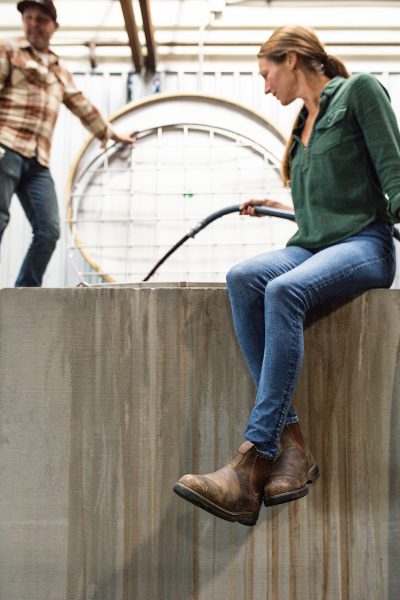
Even normal harvest is hectic and crazy and a lot of work, but this one, between the you-know-what and wildfires, even more so. Where do you guys go to reset and find inspiration, to get the creativity going again?
Scott: Oh, geez. Man. We always do a post-harvest trip. We actually really want to go back to Mexico. Jenny would move there in a second if she could. I think this year, we’re just going to Palm Springs. But we go to Big Sur. We do the town of Mendocino. Any place that’s just quiet and pretty. Hopefully warm after harvest to still get some sun. That’s why we’re going down to Palm Springs. But anything quiet and pretty, relatively isolated.
Jenny: Disconnect for a second.

